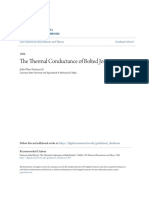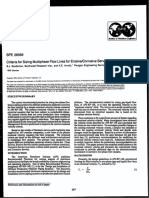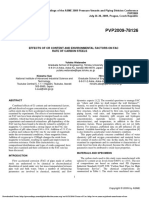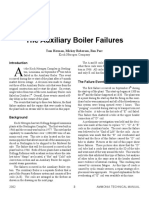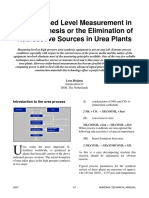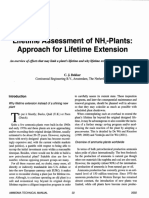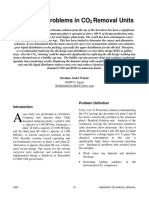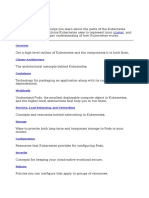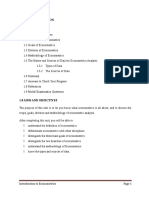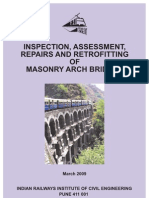Strain-Age Cracking of Alloy 601 Tubes at 600 C: Henrik Stahl
Strain-Age Cracking of Alloy 601 Tubes at 600 C: Henrik Stahl
Uploaded by
varatharajan g rOriginal Description:
Original Title
Copyright
Available Formats
Share this document
Did you find this document useful?
Is this content inappropriate?
Report this DocumentCopyright:
Available Formats
Strain-Age Cracking of Alloy 601 Tubes at 600 C: Henrik Stahl
Strain-Age Cracking of Alloy 601 Tubes at 600 C: Henrik Stahl
Uploaded by
varatharajan g rCopyright:
Available Formats
Strain-Age Cracking of Alloy 601
Tubes at 600 C
Metal dusting can cause a significant amount of expensive damage to ammonia, hydrogen, carbon
monoxide and methanol plants. One of the means to limit this development has been to design the
equipment parts, considered subject to metal dusting attack with Alloy 601. This will typically mean
parts subjected to a reformed gas at 600°C (1,HO°F). The risk of stress relaxation cracking of Alloy
601 at exactly this temperature has not previously been reported, but it must be considered a major
risk that has to be dealt with in the design phase.
Henrik Stahl
Haldor Topsoe A/S, Haldor Topsoe A/S, Lyngby, Denmark
Gaylord Smith
Inco Alloys International, Huntington, WV
Sophie Wastiaux
Air Liquide, Champigny-sur-Mame Cedex, France
Introduction for the reforming reaction. This is one of the features
of a Haldor Tops0e Convection Reformer (HTCR).
The carbon activity of the reformed gas necessitates
S
team reforming of natural gas is considered the
most economic process for industrial hydrogen that special care is taken in the selection of materials
production. By this process, a mixture of for the flow channels for the reformed gas. There is a
methane and steam forms hydrogen, carbon monoxide, risk of metal dusting corrosion. As a consequence,
and carbon dioxide while flowing through a catalyst Alloy 601 was selected for certain components of the
bed. Steam reforming is a strongly endothermic HTCR.
process. Heat is therefore required for the reaction, as After one year of operation, one HTCR exhibited
well as for elevation of the reaction temperature. certain kind of cracks in the Alloy 601 components.
Steam reforming can take place in a tubular The cracks were caused by strain-age cracking, which
reformer. A mixture of methane and steam at 500°C has not been observed previously in connection with
(930°F) and 30 bar (435 psi) is flowing through a Alloy 601.
number of catalyst-filled tubes in parallel. The tubes After relevant heat treatment and certain geometrical
are heated on the outside, and the product gas leaves changes of the 601 components, the HTCR has been
the catalyst tube up to 900°C (1,650°F). brought back to normal operation.
The consumption figures of this process are among
other things depending on the feed gas steam to car- Haldor Tops0e Convection Reformer
bon ratio and on the recuperation of the sensible heat
of the reformed gas. The best utilization of this heat is The HTCR is a tubular reformer with bayonet tubes.
by conducting it back to the process as a heat source A number of reformer tubes are placed in a tube
AMMONIA TECHNICAL MANUAL 21 2000
Outlet Reformed
Gas Nozzle.' Gas Outlet
flue Gas
Outlet Feed Gas
Chamber Inlet
Crack "I Flue Gas
Location Outlet
Inlet
Cas Nozzle
Flue Gas
"nib c
Figure 1. HTCR. Figure 2. HTCR tube.
sheet at the top of a vertical shell. A concentric flue Cracks
gas tube surrounds each reformer tube. The HTCR is
shown in Figure 1. Two skid-mounted hydrogen production units, each
At the bottom, the shell is connected to a horizontal with a capacity of 5,000 Nm3/h have been installed in
combustion chamber where hydrocarbon is combusted Belgium. A picture of this plant is shown in Photo 1.
with air to form a flue gas of 1,250°C (2,280°F). This After having been in operation for one year, a crack
flue gas is flowing into the reformer shell and is then was observed at one hairpin close to the outlet header.
conducted through the annular channel between the The location is indicated on Figure 1.
flue-gas tube and the reformer tube to the flue-gas out- The crack was located in the heat-affected zone of
let chamber. It leaves the reformer through the flue- the welding. It had developed in parallel to the weld-
gas outlet nozzle. ing (along the fusion line) and looked like a brittle
The feed gas flows through the inlet gas nozzle at rupture. The micrograph in Figure 3 shows the typical
the top of the reformer shell and is then distributed intergranular crack.
through a manifold system to the inlet hole at the top The material of the outlet manifold system is Alloy
of each reformer tube. The HTCR tube is shown in 601. This alloy was selected because the reformed gas
Figure 2. It now flows down through the catalyst to has a high carbon potential. When the reformed gas is
the bottom end of the reformer tube. It returns through cooled from 900°C (1,650°F) to 600°C (1,110°F) in
the bayonet tube to the top end where the reformed gas the bayonet tube and is flowing further through the
exits via a 90° bend through the reformer tube wall, outlet manifold system, there is a severe risk of metal
the outlet manifold system, and further on to the gas dusting corrosion. Alloy 601 was considered one of
outlet nozzle. the most resistant materials with regard to metal dust-
ing.
The crack resulted from a kind of the so-called
strain-age or stress relaxation cracking. This has not
AMMONIA TECHNICAL MANUAL 22 2000
Figure 3. Skid-mounted Hydrogen Production Units, Belgium.
previously been reported by application of Alloy 601. carbon precipitation that over time (in this case one
However, the subsequent investigations, performed by year) reduces the ductility of the material in hot condi-
TNO, showed that Alloy 601 at a temperature between tion. A condition that may lead to stress relaxation
600°C (1,110°F) and 650°C (1,200°F) will develop cracking.
Stress Relaxation Cracking Phenomenon
Stress relaxation cracking occurs when a material,
because of limited creep ductility, cannot withstand
the inelastic strain imposed upon the alloy. The phe-
nomenon is most frequently confined to the tempera-
ture range of 500-900°C (930-1,650°F), depending on
the alloy. Experience has shown that susceptible mate-
rials usually fail within one or two years of service and
are most often, but not exclusively, associated with
welded joints.
Welded structures are particularly susceptible
because of the potential for high residual stresses (up
to the yield strength of the base material) resulting
from the welding operation that has not been post
weld heat-treated. Test material taken from compo-
nents that have failed by stress relaxation cracking will
still pass all its material specification requirements
Figure 4. Typical Intergranular Crack. adding to the perplexity associated with stress relax-
AMMONIA TECHNICAL MANUAL 23 2000
ation Cracking. (c) A new piece of tube was welded to the outlet
Appearance of the stress relaxation cracking failure manifold.
can aid in confirming this type of failure. The crack is (d) The outlet manifold was taken away and heat-
always located on the grain boundary with cavitation treated in a furnace. The heat treatment consisted in
preceding the crack. Often, in iron-base alloys, the heating to 950°C (1,740°F) and holding this tempera-
crack contains a metallic filament enclosed by a ture for 1 h.
chromium-rich layer. The crack zone is usually hard (e) A connection of the outlet manifold was made to
(Vickers Hardness > 200 Hv). The hardness increase is the new reformer tube outlet pieces.
attributed to intermediate temperature-aging reactions Strain-age cracking or stress relaxation cracking is
often accelerated by prior cold work. known by welded constructions of certain materials at
temperatures between 600-650°C (1,110-1,200°F),
Available Materials and Post Fabrication such as Alloy 800, Alloy 617, Alloy 602 CA and oth-
Heat Treatments ers. However, 601 has not been considered susceptible
prior to this.
Alloys containing the age hardening elements (Al,
Ti, Nb plus C) are susceptible to stress relation crack- Conclusion
ing when placed in service with the age hardening
temperature range. The propensity to develop stress Metal dusting can cause a significant amount of
relaxation cracking increases with grain size and expensive damage to ammonia, hydrogen, carbon
retained cold work. Thus, an alloy, such as mill monoxide and methanol plants. One of the means to
annealed (ATSM grain size < 5) INCONEL Alloy 690 limit this development has been to design the equip-
(0.03% C max.) would be a highly resistant alloy to ment parts, considered subject to metal dusting attack
stress relaxation cracking. Many typical alloys for use with Alloy 601. This will typically mean parts subject-
within refineries, and chemical and petrochemical ed to a reformed gas at 600°C (1,110°F). The risk of
facilities contain levels of C (0.05-0.2%), Al (0.1- stress relaxation cracking of Alloy 601 at exactly this
0.5%) and Ti (0.1-1.5%) which can lead to stress temperature has not previously been reported, but it
relaxation cracking unless the alloy is given a post must be considered a major risk that has to be dealt
fabrication heat treatment. The temperature, optimized with in the design phase.
for each alloy, eliminates the effects of retained cold The means to avoid or minimize the risk of cracks
work and welding stresses, coarsens the grain bound- could be one or more of the following:
ary precipitates, minimizes any Cr gradient adjacent to • Arrange the process design so as to avoid tempera-
the grain boundary, which may have resulted from Cr- tures between 575°C (1,065°F) and 650°C (1,200°F).
containing carbide precipitation and, finally, establish- • Select a material that combines good resistance
es a grain matrix more likely to form a coarser (less against metal dusting and which does not develop the
damaging) age hardening precipitate. For Alloy 601, precipitation that causes stress relaxation cracking. It
such a temperature is believed to be 900-1,000°C could be Inconel 690.
(1,650-1,830°F) for between one and three hours. • Include proper heat treatment of the reactor and
downstream equipment, which operates in this temper-
HTCR Repair and Modifications ature range.
After having realized the phenomena, it was decided Literature Cited
to take the following actions:
(a) All connections between reformer tubes and out- Van Wortel, J.C., " "Relaxation Cracking in the
let header system were cut. Process Industry an Underestimated Problem," TNO
(b) Tube pieces next to the problematic area were Institute of Industrial Technology, Apeldorn, The
removed. Netherlands.
AMMONIA TECHNICAL MANUAL 24 2000
You might also like
- EP500 English Technical Manual From Serial No 266 With E100 InterfaceDocument29 pagesEP500 English Technical Manual From Serial No 266 With E100 InterfaceYenireé Medina100% (1)
- Corrosion Damage in Waste Heat Boilers Major Root Causes and RemediationDocument10 pagesCorrosion Damage in Waste Heat Boilers Major Root Causes and Remediationvaratharajan g r100% (1)
- The Interaction of Mercury and Aluminium in Heat Exchangers in A Natural Gas PDFDocument7 pagesThe Interaction of Mercury and Aluminium in Heat Exchangers in A Natural Gas PDFToth IstvanNo ratings yet
- Steam Tables - SaturatedDocument4 pagesSteam Tables - SaturatedFarouk BassaNo ratings yet
- Fatigue Failure Resulting From Variable Loading 1-2Document24 pagesFatigue Failure Resulting From Variable Loading 1-2Rahul Singh100% (1)
- TWI DVS Welding9Ni JHandFN WeldingCuttingApril2007 Pp103to112 PDFDocument12 pagesTWI DVS Welding9Ni JHandFN WeldingCuttingApril2007 Pp103to112 PDFiTuan Khai TruongNo ratings yet
- Metal Dusting Corrosion Initiation in Conversion of Natural Gas To Synthesis GasDocument24 pagesMetal Dusting Corrosion Initiation in Conversion of Natural Gas To Synthesis GasPrasanna RajaNo ratings yet
- UFC-85 Plants For Urea Fertilizer Projects: Recommended DosageDocument8 pagesUFC-85 Plants For Urea Fertilizer Projects: Recommended Dosagevaratharajan g rNo ratings yet
- Failure of Inner Shell of Double Walled Atmospheric Ammonia TankDocument9 pagesFailure of Inner Shell of Double Walled Atmospheric Ammonia Tankvaratharajan g rNo ratings yet
- Ammonia Plant Benchmarking - Historic ProgressDocument8 pagesAmmonia Plant Benchmarking - Historic Progressvaratharajan g rNo ratings yet
- New Zealand Fast Food IndustryDocument12 pagesNew Zealand Fast Food IndustryPutra Anggita100% (2)
- A Re-Think of The Mercury Removal Problem For LNG PlantsDocument10 pagesA Re-Think of The Mercury Removal Problem For LNG PlantshortalemosNo ratings yet
- Solid 186Document23 pagesSolid 186Bhavik MakaniNo ratings yet
- Crack Arrest Properties of 9% Ni Cryogenic Steel AWS JournalDocument5 pagesCrack Arrest Properties of 9% Ni Cryogenic Steel AWS JournalElias KapaNo ratings yet
- An Investigation of Transient Thermal Analysis of 1 Stage Gas Turbine Blade Manufactured by Directional Solidification and Mechanically Alloyed Nickel-Based SuperalloysDocument12 pagesAn Investigation of Transient Thermal Analysis of 1 Stage Gas Turbine Blade Manufactured by Directional Solidification and Mechanically Alloyed Nickel-Based SuperalloyshidaiNo ratings yet
- Oto 99022Document157 pagesOto 99022jobinhoeljovenNo ratings yet
- Cryo Duplex SsDocument220 pagesCryo Duplex SssivaNo ratings yet
- Avoiding Acoustic-Induced VibrationDocument4 pagesAvoiding Acoustic-Induced VibrationRajesh RagoobirNo ratings yet
- Welding LNG Tank and Vessel in 5 and 9 Nickel SteelDocument4 pagesWelding LNG Tank and Vessel in 5 and 9 Nickel Steelויליאם סן מרמיגיוסNo ratings yet
- Erosion Due To FlowDocument3 pagesErosion Due To FlownguyenNo ratings yet
- Simon Frost 2011Document23 pagesSimon Frost 2011bluemasNo ratings yet
- The Thermal Conductance of Bolted Joints PDFDocument207 pagesThe Thermal Conductance of Bolted Joints PDFGabrielHabibNo ratings yet
- Vertical Wave-in-Deck Loading and Pressure Distribution On Fixed Horizontal Decks of Offshore PlatformsISOPE-I-14-058Document9 pagesVertical Wave-in-Deck Loading and Pressure Distribution On Fixed Horizontal Decks of Offshore PlatformsISOPE-I-14-058klop disposableNo ratings yet
- Fatigue Reliability of Welded Steel Structures.Document11 pagesFatigue Reliability of Welded Steel Structures.Malik BetaNo ratings yet
- 1911-Article Text-5977-1-10-20120619 PDFDocument4 pages1911-Article Text-5977-1-10-20120619 PDFyoustruelyNo ratings yet
- Post Processing of Mild Steel Undergoing MIG WeldingDocument43 pagesPost Processing of Mild Steel Undergoing MIG Weldingnina felixNo ratings yet
- Electrodo Lincoln 7018Document2 pagesElectrodo Lincoln 7018Erick Quan Luna100% (1)
- Austenitic High Temperature 153MA 253MA Stainless BrochureDocument16 pagesAustenitic High Temperature 153MA 253MA Stainless BrochurezosternatNo ratings yet
- Trelleborg O RingDocument193 pagesTrelleborg O RingfeltofsnakeNo ratings yet
- ELSEVIER Carburization of High-Temperature Steels - A Simulation-Based Ranking of Carburization ResistanceDocument8 pagesELSEVIER Carburization of High-Temperature Steels - A Simulation-Based Ranking of Carburization ResistanceMariaF1593No ratings yet
- Welding of Ni Alloy-IraqDocument17 pagesWelding of Ni Alloy-Iraqkhairy2013No ratings yet
- High Temperature CorrosionDocument16 pagesHigh Temperature CorrosionBubai111100% (1)
- DOT Pipeline RepairsDocument18 pagesDOT Pipeline RepairsSeng HeangNo ratings yet
- A Guideline To Calculate Erosional Velocity Due To Liquid Droplets For Oil and Gas IndustryDocument13 pagesA Guideline To Calculate Erosional Velocity Due To Liquid Droplets For Oil and Gas IndustryErika Caicedo100% (1)
- Radiation ConversionDocument2 pagesRadiation ConversionGaurav Bansal0% (1)
- Corrosion Prevention For MetalsDocument17 pagesCorrosion Prevention For Metalsabdul100% (1)
- Impact of Boiler Water Chemistry On Wate PDFDocument8 pagesImpact of Boiler Water Chemistry On Wate PDFace-winnieNo ratings yet
- The Role of Alloying Elements in The Design of Nickel-Base SuperalloysDocument19 pagesThe Role of Alloying Elements in The Design of Nickel-Base SuperalloysJ. GirotoNo ratings yet
- Characteristic of High Temperature MaterialsDocument17 pagesCharacteristic of High Temperature MaterialsMuhammad Salman AttariNo ratings yet
- Failure Analysis of Reformer Tubes: Technicalarticle-Peer-ReviewedDocument6 pagesFailure Analysis of Reformer Tubes: Technicalarticle-Peer-ReviewedOwais MalikNo ratings yet
- Uk Finned Technic HeatingspaceDocument18 pagesUk Finned Technic HeatingspacetuzlucayirNo ratings yet
- Cold Cracking of Welds SodelDocument2 pagesCold Cracking of Welds Sodelfaridshabani100% (1)
- 226 Eddystone Station UnitDocument24 pages226 Eddystone Station UnitsbktceNo ratings yet
- Alsco: Chemical Resistance GuideDocument55 pagesAlsco: Chemical Resistance GuidejcndNo ratings yet
- SPE26569 Erosional VelcityDocument12 pagesSPE26569 Erosional VelcityOluwatosinImisioluwaAjiboye100% (1)
- Weldability Testing For Advanced MaterialsDocument8 pagesWeldability Testing For Advanced MaterialsJim BetsingerNo ratings yet
- Boiler Corrosion MagnetiteDocument14 pagesBoiler Corrosion MagnetiteJakeTheSnake69100% (1)
- GRP Pipe Case History - Revised Shoiaba Eng Large DiaDocument4 pagesGRP Pipe Case History - Revised Shoiaba Eng Large DiaA.Subin DasNo ratings yet
- 07 Thermal StressDocument13 pages07 Thermal StressSundaravathanan ChellappanNo ratings yet
- PVP2017 66173Document9 pagesPVP2017 66173King SabiNo ratings yet
- Reduction of The Hydrogen Content in The Continuous Casting of SteelDocument7 pagesReduction of The Hydrogen Content in The Continuous Casting of SteelBrigida Pagani0% (1)
- Articulo SPEDocument7 pagesArticulo SPEchirinoslaaNo ratings yet
- Chap 32 PDFDocument18 pagesChap 32 PDFnelson escuderoNo ratings yet
- Advance Vanadium Modified Steels For High Pressure Hydrogen ReactorsDocument7 pagesAdvance Vanadium Modified Steels For High Pressure Hydrogen ReactorsMatthieuNo ratings yet
- 1584Document6 pages1584malsttarNo ratings yet
- Stainless Steel 410Document2 pagesStainless Steel 410Suriyachai NiamsornNo ratings yet
- The Precipitation Hardening SSsDocument3 pagesThe Precipitation Hardening SSsClaudia MmsNo ratings yet
- Elevated Temperature Erosive Wear of Metallic Materials 2006 ROYDocument24 pagesElevated Temperature Erosive Wear of Metallic Materials 2006 ROYLuiz Rafael R. SilvaNo ratings yet
- Effects of CR Content and Environmental Factors On Flow Accelerated Corrosion Rate of Carbon SteelsDocument4 pagesEffects of CR Content and Environmental Factors On Flow Accelerated Corrosion Rate of Carbon SteelsAPINo ratings yet
- Chap 20 PDFDocument18 pagesChap 20 PDFnelson escuderoNo ratings yet
- Titanium Guide PDFDocument48 pagesTitanium Guide PDFthanghanvicoNo ratings yet
- Strain-Age Cracking of Alloy 601 Tubes at 600CDocument4 pagesStrain-Age Cracking of Alloy 601 Tubes at 600CrachaelllwongNo ratings yet
- Gas Purging Induction FurnaceDocument6 pagesGas Purging Induction FurnaceIrfan AhmedNo ratings yet
- Heat Treatment Landing GearsDocument5 pagesHeat Treatment Landing GearstoufiquetoufiqueNo ratings yet
- High Temperature Service Equipment and Piping Maintenance in PlantDocument22 pagesHigh Temperature Service Equipment and Piping Maintenance in Plantvaratharajan g r100% (1)
- Consideration of Fatigue Life in The Design of Vessels in Molecular Sieve Dryer ServiceDocument9 pagesConsideration of Fatigue Life in The Design of Vessels in Molecular Sieve Dryer Servicevaratharajan g rNo ratings yet
- Assuring The Safety of Ammonia Plant Vessels and Piping Using API RP 579Document11 pagesAssuring The Safety of Ammonia Plant Vessels and Piping Using API RP 579varatharajan g rNo ratings yet
- Pushing The Limits - Breakthrough in Pre-Reformer Design: Ingo Hanke and Norbert RingerDocument6 pagesPushing The Limits - Breakthrough in Pre-Reformer Design: Ingo Hanke and Norbert Ringervaratharajan g rNo ratings yet
- Aspen Exchanger Design and Rating Shell & Tube V10: File: Printed: 1/31/2023 at 3:41:24 PM TEMA SheetDocument1 pageAspen Exchanger Design and Rating Shell & Tube V10: File: Printed: 1/31/2023 at 3:41:24 PM TEMA Sheetvaratharajan g rNo ratings yet
- Scanner GuideDocument48 pagesScanner Guidevaratharajan g rNo ratings yet
- Engro's Experience With Implementation of A S-300 Converter During A Normal T/ADocument10 pagesEngro's Experience With Implementation of A S-300 Converter During A Normal T/Avaratharajan g rNo ratings yet
- Catalyst Catastrophes II: John Brightling and DR Mike RobertsDocument12 pagesCatalyst Catastrophes II: John Brightling and DR Mike Robertsvaratharajan g rNo ratings yet
- The Auxiliary Boiler Failures: Tom Herman, Mickey Roberson, Ron ParrDocument5 pagesThe Auxiliary Boiler Failures: Tom Herman, Mickey Roberson, Ron Parrvaratharajan g rNo ratings yet
- Technical Audit of Older Ammonia Plants: Ken Northcutt, Robert Collins, and S. MadhavanDocument12 pagesTechnical Audit of Older Ammonia Plants: Ken Northcutt, Robert Collins, and S. Madhavanvaratharajan g rNo ratings yet
- Waste Heat Boiler (101-C) Leakages & Possible Causes: Paper AbstractDocument16 pagesWaste Heat Boiler (101-C) Leakages & Possible Causes: Paper Abstractvaratharajan g rNo ratings yet
- 50 Year History of The Aiche Ammonia Safety Symposium: Gerald P. WilliamsDocument9 pages50 Year History of The Aiche Ammonia Safety Symposium: Gerald P. Williamsvaratharajan g rNo ratings yet
- Pressure Drop Improvements in A Fixed Bed ReactorDocument10 pagesPressure Drop Improvements in A Fixed Bed Reactorvaratharajan g rNo ratings yet
- Commissioning of The First Ammonia-Urea Complex: A Challenging Venture For The Vietnamese EconomyDocument13 pagesCommissioning of The First Ammonia-Urea Complex: A Challenging Venture For The Vietnamese Economyvaratharajan g rNo ratings yet
- Revamping of The PCS Nitrogen 03 Plant in Trinidad: Elizabeth West-ToolseeDocument7 pagesRevamping of The PCS Nitrogen 03 Plant in Trinidad: Elizabeth West-Toolseevaratharajan g rNo ratings yet
- Properties and Microstructures of Outlet Manifold ComponentsDocument12 pagesProperties and Microstructures of Outlet Manifold Componentsvaratharajan g r100% (1)
- Bimetallic and Alloy Welds in HP Hydrogen and Nitrogen ServiceDocument18 pagesBimetallic and Alloy Welds in HP Hydrogen and Nitrogen Servicevaratharajan g rNo ratings yet
- Legionella Pneumophila in An Ammonia Plant Cooling Tower: W. D. VerduijnDocument15 pagesLegionella Pneumophila in An Ammonia Plant Cooling Tower: W. D. Verduijnvaratharajan g rNo ratings yet
- High Temperature Service Equipment and Piping Maintenance in PlantDocument22 pagesHigh Temperature Service Equipment and Piping Maintenance in Plantvaratharajan g r100% (1)
- Risk Based Assessment of A 25,000 Ton Ammonia Storage Tank: D. Daly, Gregory J. Deis, D. Mclntyre, and R. SmallwoodDocument8 pagesRisk Based Assessment of A 25,000 Ton Ammonia Storage Tank: D. Daly, Gregory J. Deis, D. Mclntyre, and R. Smallwoodvaratharajan g rNo ratings yet
- Radar-Based Level Measurement in Urea Synthesis or The Elimination of Radioactive Sources in Urea PlantsDocument10 pagesRadar-Based Level Measurement in Urea Synthesis or The Elimination of Radioactive Sources in Urea Plantsvaratharajan g rNo ratings yet
- Lifetime Assessment of NH - Plants: Approach For Lifetime ExtensionDocument12 pagesLifetime Assessment of NH - Plants: Approach For Lifetime Extensionvaratharajan g rNo ratings yet
- New KBR Process For Coal To Ammonia: Kamal Gursahani, Siva Ariyapadi, Meghji Shah and Richard StraitDocument12 pagesNew KBR Process For Coal To Ammonia: Kamal Gursahani, Siva Ariyapadi, Meghji Shah and Richard Straitvaratharajan g rNo ratings yet
- Carry Over Problems in CO Removal Units: Problem DefinitionDocument10 pagesCarry Over Problems in CO Removal Units: Problem Definitionvaratharajan g rNo ratings yet
- Conversion of Sulfinol To BASF' S Amdea: SM ® SM SMDocument12 pagesConversion of Sulfinol To BASF' S Amdea: SM ® SM SMvaratharajan g rNo ratings yet
- Failure of Ammonia-1 Natural Gas Compressor TrainDocument9 pagesFailure of Ammonia-1 Natural Gas Compressor Trainvaratharajan g rNo ratings yet
- Experience of Energy Saving and Naphtha To Gas Conversion Projects at IFFCODocument16 pagesExperience of Energy Saving and Naphtha To Gas Conversion Projects at IFFCOvaratharajan g rNo ratings yet
- Scogen - Coarse Disc Type DiffuserDocument2 pagesScogen - Coarse Disc Type Diffuserbharankaromkar777No ratings yet
- Concepts KubernetesDocument642 pagesConcepts Kubernetesjustin jazzNo ratings yet
- The Atlas of The New LibrarianshipDocument263 pagesThe Atlas of The New LibrarianshipKeke Ferreira100% (1)
- Gadget AddictionDocument8 pagesGadget AddictionkNo ratings yet
- Hofstede Questionnaire and Self-ScoringDocument2 pagesHofstede Questionnaire and Self-Scoringeliainesadele.hamoucheNo ratings yet
- CompositeDocument25 pagesCompositeNind's ChefNo ratings yet
- Calculations For Design Parameters of TransformerDocument34 pagesCalculations For Design Parameters of TransformerUday KoliNo ratings yet
- SASBADI - Annual Report 2014Document146 pagesSASBADI - Annual Report 2014Jamie TanNo ratings yet
- Analysis of Distribution Channel of AmulDocument36 pagesAnalysis of Distribution Channel of AmulTAHJNo ratings yet
- Taking Your Company Green - PPTX: Slide MastersDocument5 pagesTaking Your Company Green - PPTX: Slide MastersAnh ThuNo ratings yet
- 2017-18 Microwave Engineering 6th SemDocument2 pages2017-18 Microwave Engineering 6th SemPulkit GoelNo ratings yet
- EN - It Takes A Village - Ana Maria CiobanuDocument13 pagesEN - It Takes A Village - Ana Maria CiobanuAna Maria CiobanuNo ratings yet
- 1967 - Evan BlackDocument13 pages1967 - Evan BlackGustavo CanepaNo ratings yet
- C8 Rizals Changing View and Spanish RuleDocument11 pagesC8 Rizals Changing View and Spanish RuleBARCELON, CHRISTOPHER JAMESNo ratings yet
- Doctor Test For Petroleum Distillates: UOP Method 41-74 ScopeDocument2 pagesDoctor Test For Petroleum Distillates: UOP Method 41-74 ScopeHamid Hamido Hamido100% (1)
- Case Application: Higher and HigherDocument6 pagesCase Application: Higher and HigherJomarie AlcanoNo ratings yet
- KASILINGAMLINGARAJA Lunar Effect and Stock MarketDocument4 pagesKASILINGAMLINGARAJA Lunar Effect and Stock MarketMukeshChauhanNo ratings yet
- Econometrics Module 2Document185 pagesEconometrics Module 2Neway Alem100% (1)
- Arch BridgesDocument131 pagesArch BridgesImtiaz Hisam100% (2)
- Tiger AirDocument3 pagesTiger AirTHUHTETTHIHANo ratings yet
- (2019) - Nandrolone Decanoate Relieves Joint Pain in Hypogonadal Men Men: A Novel Prospective Pilot Study and Review of The LiteratureDocument9 pages(2019) - Nandrolone Decanoate Relieves Joint Pain in Hypogonadal Men Men: A Novel Prospective Pilot Study and Review of The LiteratureGuilherme LealNo ratings yet
- 53 Meralco v. Lim - Capellan, GlecieDocument2 pages53 Meralco v. Lim - Capellan, GlecieFroilan Villafuerte FaurilloNo ratings yet
- Akash ADocument42 pagesAkash ABalaKrishnaNo ratings yet
- Spouses Frias vs. AbaoDocument3 pagesSpouses Frias vs. Abaokristian datinguinooNo ratings yet
- Assignment Nursing Care Plan NursDocument6 pagesAssignment Nursing Care Plan NursChandrashyamNo ratings yet
- TDP 06-796-066 PreviewDocument7 pagesTDP 06-796-066 PreviewSusan Lam100% (1)
- Auto ID: General CatalogueDocument40 pagesAuto ID: General CataloguethaoNo ratings yet
- Basis of Design ReportDocument121 pagesBasis of Design ReportINDERJIT GHAINo ratings yet





















